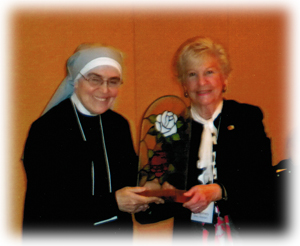
 Mother Isabel recently received the Kentucky Right to Life’s 2010 Red Rose – White Rose award on behalf of the Little Sisters of the Poor. In the photo at left, she is presented with the award by Margie Montgomery, Executive Director of Kentucky Right to Life.
Mother Isabel recently received the Kentucky Right to Life’s 2010 Red Rose – White Rose award on behalf of the Little Sisters of the Poor. In the photo at left, she is presented with the award by Margie Montgomery, Executive Director of Kentucky Right to Life.
We’re all familiar with the Red Rose as a symbol of the pro-life movement’s respect for the lives of preborn babies and their mothers. But are you knowledgeable about the history of the White Rose?
By the mid-1930s, ending the lives of those deemed physically or socially unfit was openly accepted in Germany. By 1939 the “mercy killing” of babies born with abnormalities, the elderly, the chronically or incurably ill, the mentally ill, and the physically or mentally disabled was officially legal. This “mercy killing” should not be confused with the Nazis’ systematic slaughter of the Jewish population. The euthanasia program began years before the Holocaust. Nor was the concept of “a life not worth living” a Nazi invention. Internationally known scientists, psychiatrists and jurists had promoted the idea for at least 13 years before Hitler came to power. In fact, the “help in dying” program was considered such a “benefit” that only German citizens were eligible for mercy killing.
The killing was conceived, run and executed by doctors. Psychiatrists played a pivotal role in the selections for the killing centers. At first, the means used for such killing was starvation, followed later by lethal injections, and finally by the more economical and efficient use of carbon monoxide and cyanide gas.
Only a few spoke against the German ‘mercy’ killing program. One of those was Clemens Count von Galen, the Bishop of Munster. In August 1941, he delivered a now-famous sermon in which he said, “It is a terrible, unjust and catastrophic thing when a man opposes his will to the will of God.” The “terrible thing” he referred to was the government-sanctioned killing of innocent people – the physician-authorized deaths of invalids, orphans, the mentally ill and the elderly.
Hans Scholl, a young medical student, is said to have heard the bishop’s sermon and remarked, “At last, somebody has had the courage to speak out.” Scholl and a group of students then formed the Weisse Rose (White Rose). Using a small duplicating machine, the students distributed thousands of pamphlets denouncing the Nazi regime and its crimes against life. Their leaflets carried such messages as We will not be silent. We are your bad conscience. The White Rose will give you no rest.
Hans Scholl and his 22-year-old sisters Sophie, along with Professor Kurt Huber, were eventually discovered and condemned to death by a Nazi court. When confronted by a hostile judge about her activities, Sophie Scholl responded, “Somebody, after all, had to make a start.”
The White Rose is now internationally recognized as the symbol of the anti-euthanasia movement. To the culture of death, we of Kentucky Right to Life reply,
“We will not be silent.
We are your bad conscience.
We, who continue in the spirit of the White Rose, will give you no rest.”




Red Rose – White Rose Award